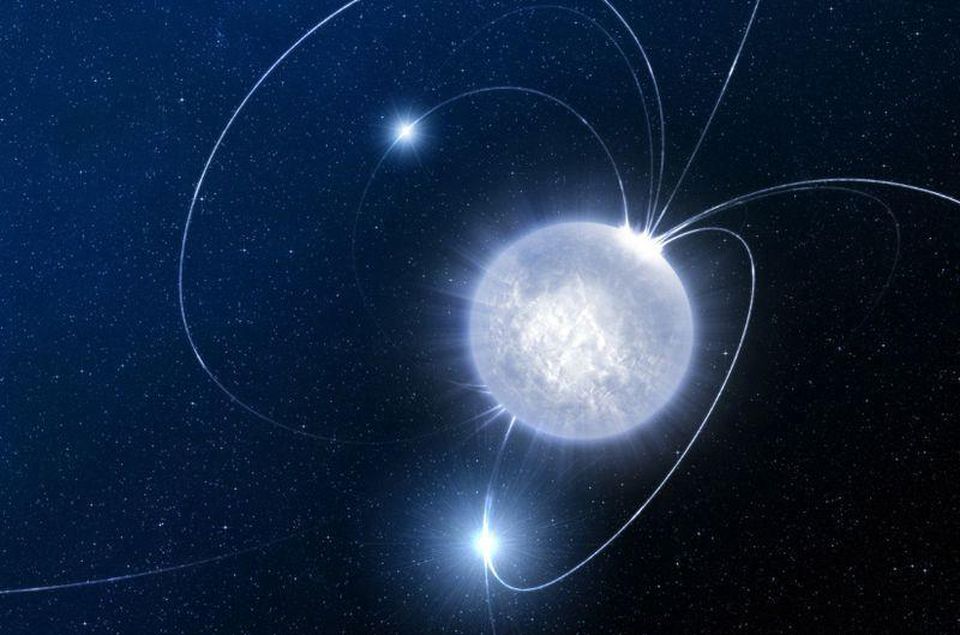 Neutron star is one of the most dense forms of matter of the Universe, but its mass is the upper limit. If you exceed it, the neutron star will collapse into a black hole.
Neutron star is one of the most dense forms of matter of the Universe, but its mass is the upper limit. If you exceed it, the neutron star will collapse into a black hole.There are few fixed objects in the universe; almost all the bodies known to us rotate. Each moon, planet, star from the known to us, rotates around its axis, therefore in our physical reality there are no ideal spheres. An object in hydrostatic equilibrium, during rotation, inflates at the equator and contracts with the poles. Our Earth, thanks to one revolution per day, along the equatorial axis is 42 km longer than the polar one, and there are objects that rotate much faster. What about the fastest rotating objects? Our reader asks:
Some pulsars spin surprisingly fast. How much does it distort their form, and do they not drop matter because of it - or does their gravity hold it?
There are restrictions on the speed of rotation of objects, and although pulsars are no exception, some of them can be called truly exceptional.
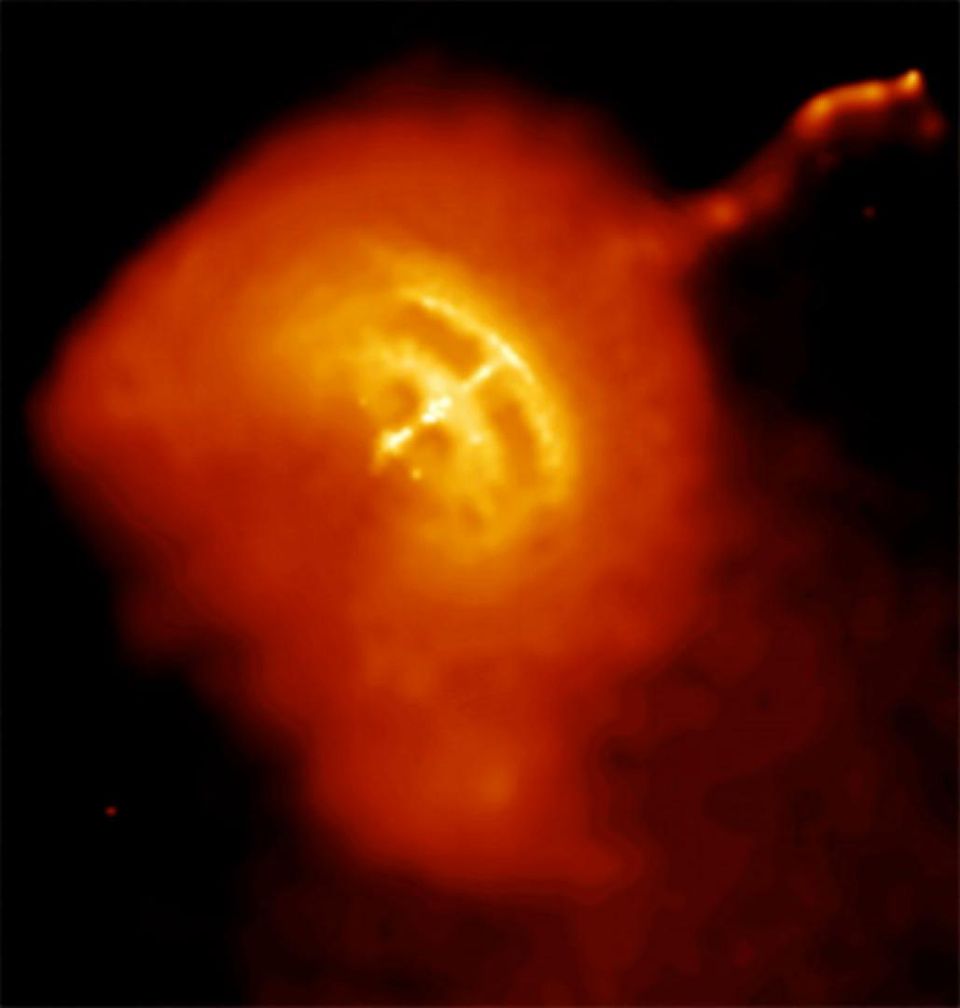 Pulsar in Sails , like all pulsars, is an example of the remains of a neutron star. Gas and matter quite often surround pulsars, and they are sources of fuel for the pulsating behavior of these neutron stars.
Pulsar in Sails , like all pulsars, is an example of the remains of a neutron star. Gas and matter quite often surround pulsars, and they are sources of fuel for the pulsating behavior of these neutron stars.Pulsars, or rotating neutron stars, possess one of the most incredible properties among all objects of the Universe. They appear after the supernova, when the nucleus collapses to the state of a solid ball of neutrons, exceeding the Sun mass, but having a diameter of only a few kilometers. This is the most dense form of matter known. And although they are called neutron stars, they consist of only 90% of neutrons, so when rotating, the charged particles that they have move very quickly and create a strong magnetic field. When the particles around them enter this field, they are accelerated, and a
relativistic jet , or jet, emanating from the poles of a neutron star appears. And when one of these poles points in our direction, we see the "impulse" of the pulsar.
 A pulsar consisting of neutrons has an outer shell of protons and neutrons, creating an extremely strong magnetic field, a trillion times greater than that on the surface of the Sun. Note that the axis of rotation and the magnetic axis slightly differ.
A pulsar consisting of neutrons has an outer shell of protons and neutrons, creating an extremely strong magnetic field, a trillion times greater than that on the surface of the Sun. Note that the axis of rotation and the magnetic axis slightly differ.Most of the existing neutron stars do not look like pulsars for us, since most of them are not turned so that the axis of rotation coincides with the line of sight. It is possible that all neutron stars are pulsars, but we can see only a small fraction of their pulses. Nevertheless, even in the observed pulsars there is a huge variation in the number of revolutions.
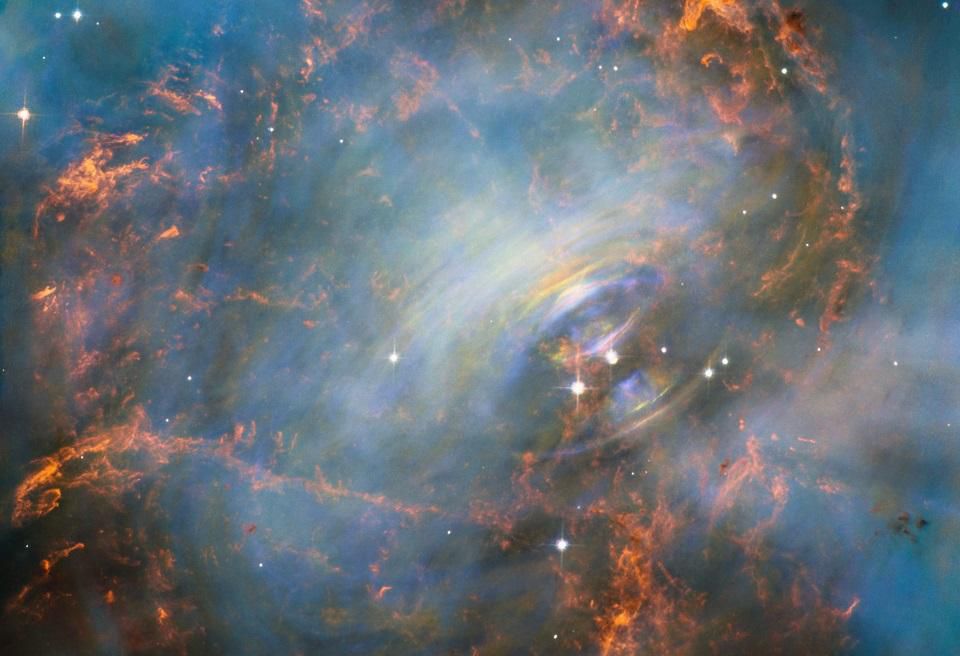 On the image of the core of a crab nebula - a young and massive star that recently died in a stunning supernova explosion - you can see the characteristic waves generated by a pulsating and rapidly rotating neutron star, a pulsar. This young pulsar with an age of only 1000 years, rotating 30 times per second, is a typical representative of ordinary pulsars.
On the image of the core of a crab nebula - a young and massive star that recently died in a stunning supernova explosion - you can see the characteristic waves generated by a pulsating and rapidly rotating neutron star, a pulsar. This young pulsar with an age of only 1000 years, rotating 30 times per second, is a typical representative of ordinary pulsars.Regular pulsars, to which most young pulsars belong, spend a full turn from a few hundredths of a second to a few seconds, and older, millisecond pulsars rotate much faster. The fastest known pulsar rotates 766 times per second, and the slowest RCW 103 found in the center of a 2000-year-old supernova
turns around in an incredible 6.7 hours .
 A very slowly rotating neutron star in the core of supernova remnants RCW 103 is also a magnetar . In 2016, new data from different satellites confirmed that it is the slowest rotating neutron star of all known
A very slowly rotating neutron star in the core of supernova remnants RCW 103 is also a magnetar . In 2016, new data from different satellites confirmed that it is the slowest rotating neutron star of all knownA couple of years ago the
incorrect story that a slowly rotating star turned out to be the closest object to a sphere known to mankind was walking on the net. Unlikely! The sun is very close to the ideal sphere, and in the equatorial plane only 10 km greater than the diameter along the axis between the poles (that is, differs from the ideal sphere by 0.0007%), and the recently discovered star KIC 11145123 is more than twice the Sun size, but the difference in equator and poles is only 3 km.
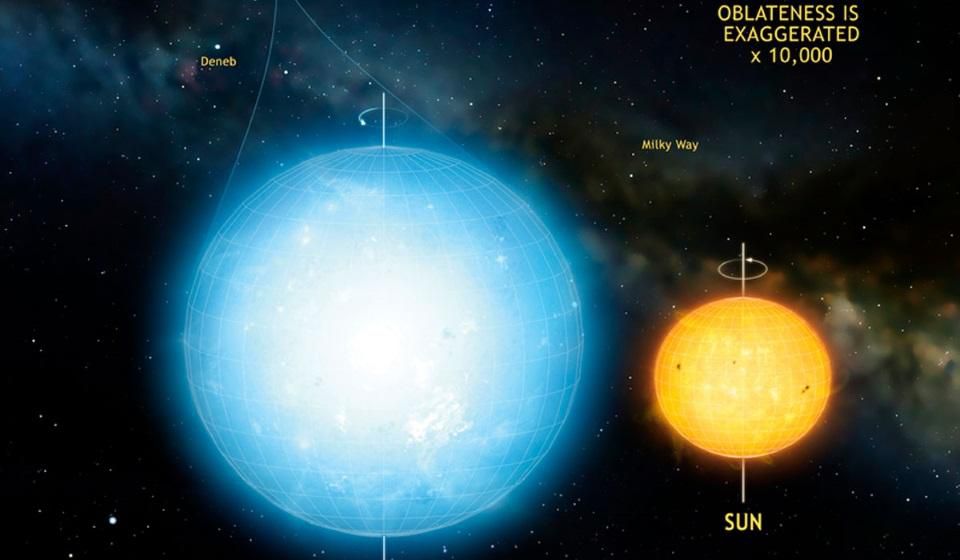 In the slowest rotating star known to us, Kepler / KIC 1145123, the diameters of the poles and the equator differ by only 0.0002%. However, neutron stars can be much smoother.
In the slowest rotating star known to us, Kepler / KIC 1145123, the diameters of the poles and the equator differ by only 0.0002%. However, neutron stars can be much smoother.However, although the difference of only 0.0002% from the ideal sphere is a good result, all these records are beaten by the slowest of all rotating neutron stars, known as
1E 1613 . Its diameter is about 20 km, and the difference between the equatorial and polar radii does not exceed the proton radius: it is less than one trillion from 1%. Of course, if we can be sure that the shape of a neutron star is determined by its rotational dynamics.
But perhaps, in fact, this is not the case, and the correctness of this statement plays a huge role in the study of the other side of the coin - the most rapidly rotating neutron stars.
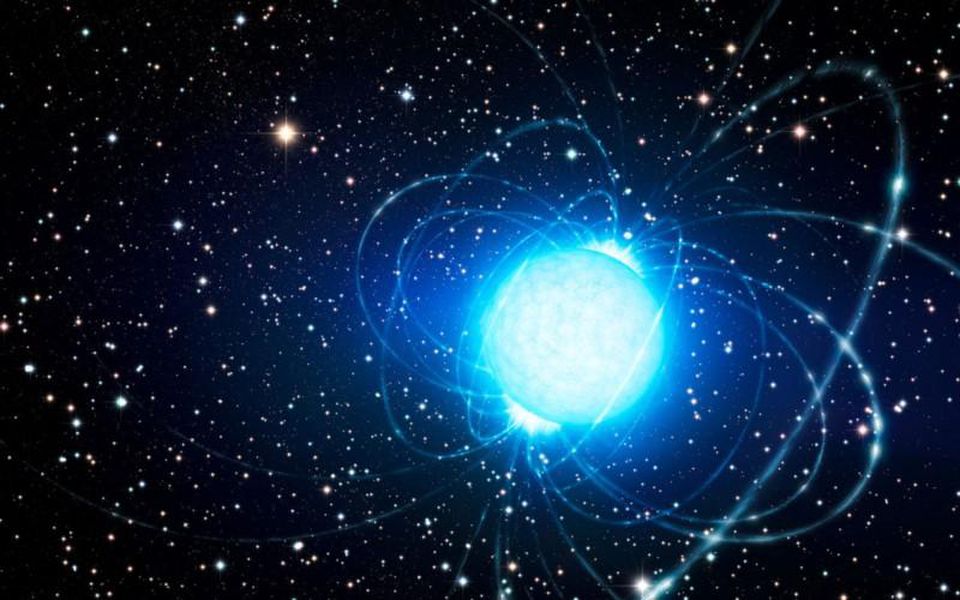 The neutron star is small and dim, but it is very hot and it cools down for a very long time. If we could watch her and see her glow, we would see how she shines millions of times longer than the current age of the Universe.
The neutron star is small and dim, but it is very hot and it cools down for a very long time. If we could watch her and see her glow, we would see how she shines millions of times longer than the current age of the Universe.Neutron stars have an incredibly strong magnetic field - with an ordinary neutron star, its intensity is 100 billion gauss, and for magnetars, which have the strongest magnetic field, it is between 100 trillion to 1 quadrillion gauss. For comparison, the intensity of the Earth’s magnetic field is approximately 0.6 Gs. And if the rotation tries to flatten the neutron star and bring it to the shape of a compressed spheroid, then the magnetic fields act in the opposite direction, pulling the neutron star along the axis of rotation into a melon-like shape known as an elongated spheroid.
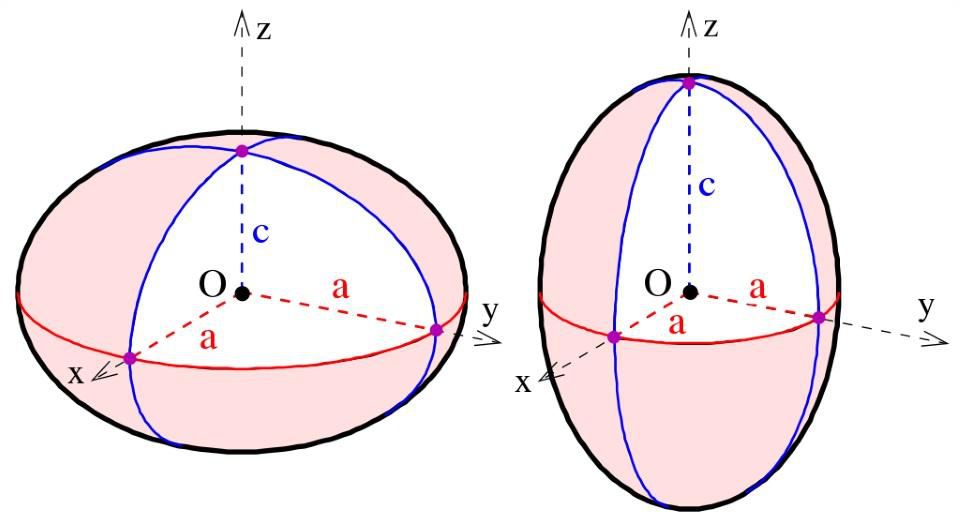 Compressed and extended spheroids
Compressed and extended spheroidsDue to the
limitations of gravitational waves, we are sure that neutron stars depart from their shape due to rotation by no more than 10-100 cm, which means that they are perfectly round with an accuracy of 0.0001%. But in fact, the deformation should be even smaller. The fastest rotating neutron star has a rotation frequency of 766 Hz, or a revolution period of 0.0013 s.
And although there are many ways to calculate flattening even for the fastest neutron stars (without the generally accepted equation), even this incredible speed, due to which the surface at the equator moves at a speed of about 16% of the speed of light, will result in a flattening of only 0.0000001% , plus or minus a couple of orders of magnitude. And it does not even come close to the speed of escape — everything that is on the surface of a neutron star will remain there.
 Just before the merger, two neutron stars not only emit gravitational waves, but also generate a catastrophic explosion, which responds along the entire electromagnetic spectrum, as well as a stream of heavy elements that are near the very end of the periodic table.
Just before the merger, two neutron stars not only emit gravitational waves, but also generate a catastrophic explosion, which responds along the entire electromagnetic spectrum, as well as a stream of heavy elements that are near the very end of the periodic table.After the merger of two neutron stars, the most extreme example of a rotating neutron star formed as a result of the merger may turn out. According to our standard theories, these neutron stars should collapse into a black hole when a certain mass threshold is exceeded: about 2.5 times the solar one. But if these neutron stars rotated rapidly, then for some time they could remain a neutron star until enough energy was emitted in the form of gravitational waves, and they did not reach the state of critical instability. Such a process can increase the maximum mass of a neutron star, at least temporarily, by 10–20%.
And we believe that this is exactly what happened during the time of the
merger of two neutron stars that we observed .
With what speed did the neutron star rotate after the merger? How distorted its shape? What gravitational waves emit neutron stars resulting from the merger?
To get an answer, it is necessary to combine the study of events that occur with the participation of masses from different ranges: the total mass does not exceed 2.5 solar (a stable neutron star should turn out), a mass of 2.5 to 3 solar ones (as in the event that we observed when a temporarily existing neutron star turns into a black hole), the mass is greater than 3 solar (when a black hole immediately turns out), and add to this the measurement of light signals. We can also learn more by detecting a phase of convergence in a spiral as early as possible, and directing telescopes in advance towards the intended source. And with the entry into service of LIGO / Virgo and other detectors of gravitational waves, as well as with an increase in their sensitivity, we manage it better and better.
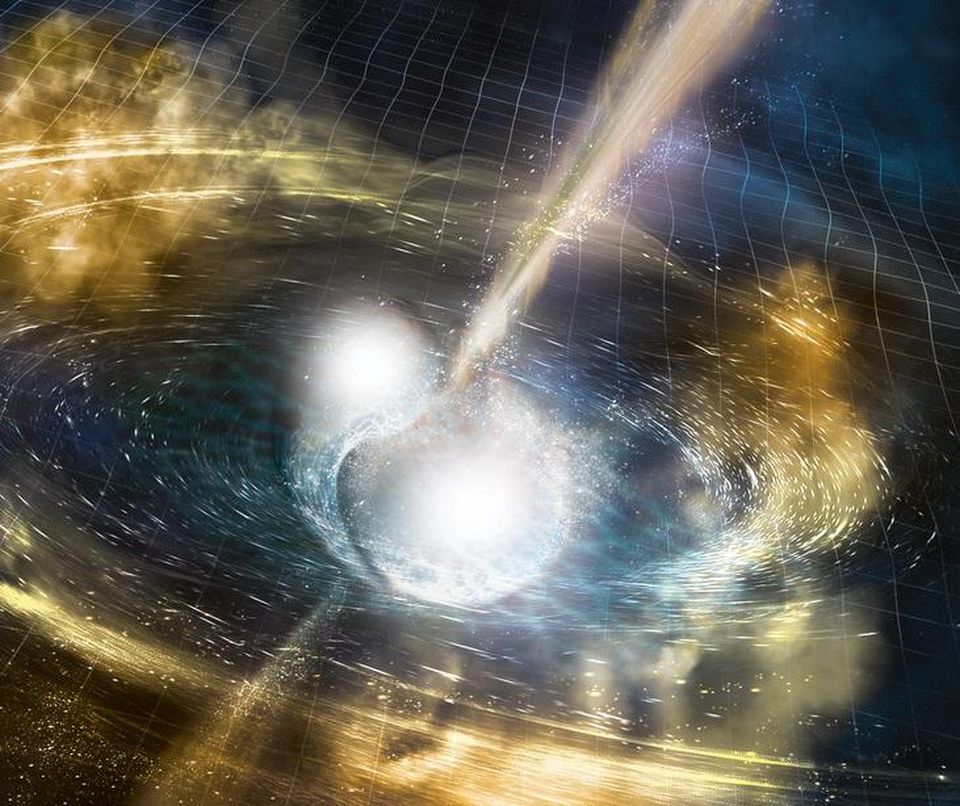 The merger of two neutron stars in the artist's view. The binary systems of neutron stars also gradually come together in a spiral and merge, but the closest of the pairs we have found will not merge for nearly another 100 million years. Until then, LIGO is likely to find many other candidates.
The merger of two neutron stars in the artist's view. The binary systems of neutron stars also gradually come together in a spiral and merge, but the closest of the pairs we have found will not merge for nearly another 100 million years. Until then, LIGO is likely to find many other candidates.Until then, know that neutron stars, despite their fast rotation, are extremely solid due to their unsurpassed density. Even with such strong magnetic fields and relativistic speeds of rotation, as they have, they are more ideal spheres than everything we could find on a macroscopic scale in the Universe. Unless the individual particles turn out to be more ideal spheres (and this can happen), slowly rotating neutron stars with weak magnetic fields will remain the best candidates for the most spherical objects from those that emerged naturally. A long-lived stable neutron star with time will only slowly reduce the speed of rotation. And everything that is on its surface will remain there.